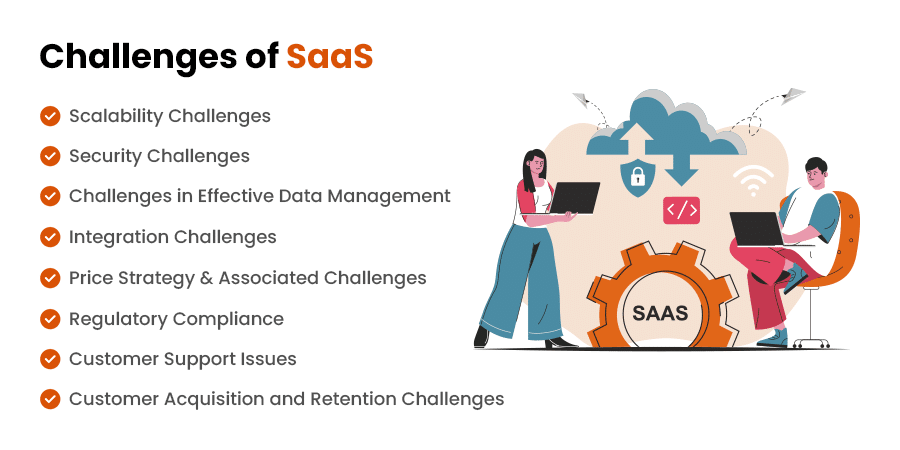The Benefits and Challenges of Building A SaaS Startup
All working professionals have to admit one statement the use of online subscription software becomes an integral part of their corporate process (especially after COVID-19).
During the pandemic, the majority of us indulged in remote working practices and SaaS software (like: Zoom) supported us to accomplish our business goals. Although, the SaaS industry faced a massive growth opportunity, especially in the last decade.
In this article, there will be a discussion about the benefits of SaaS and its challenges. So, read the below information to gain crucial facts about the SaaS advantages and disadvantages:
Overview of SaaS
Software as a Service (SaaS) is a cloud-based software delivery model where a provider hosts applications and makes them available to customers over the internet. While taking the services from a SaaS company, customers do not need to install or maintain the software, as everything is managed by the provider.
It makes it easy and cost-effective for businesses to use cloud computing software as a service without having to invest in the infrastructure required to run them. The market value of SaaS has been growing rapidly in recent years, with a compound annual growth rate (CAGR) of 11.0% from the year 2022 to 2028 research. The market size is expected to reach USD 344.3 billion by 2028.
The growth of SaaS can be attributed to several factors, including the increasing use of cloud technology, the need for flexible and scalable software solutions and the rising demand for remote work and collaboration tools.
There are many examples of advantages of software as a service application in use today. One well-known example is Salesforce, a cloud-based customer relationship management (CRM) tool that allows businesses to manage their sales and customer interactions.
Another example is Zoom, a video conferencing platform that has become popular during the COVID-19 pandemic as many people have shifted to remote work. Other popular SaaS applications include Microsoft Office 365, Dropbox and Hubspot.
Read about: Full-Stack Development and the Impact of Cloud Computing
Benefits of SaaS Company

The advantages of software as a service lie in its deployment model, whereby a cloud-based infrastructure is used by third-party providers to develop applications that are accessible to customers through the internet. Unlike traditional software that is installed on local machines, SaaS enables users to access the software from any device with an internet connection and a web browser.
1. AI and ML Capabilities
SaaS computing can leverage AI and ML to offer features such as predictive analytics and intelligent automation. This can help businesses to improve their operations and gain valuable insights into their data. For example, a SaaS provider in the healthcare industry could use AI and ML to offer personalized treatment recommendations based on a patient’s medical history.
2. Improved Disaster Recovery
As benefits of SaaS in cloud computing can offer improved disaster recoveries capabilities, such as real-time data replication and automated failover. This can help businesses to quickly recover from data loss or system failures, reducing downtime and minimizing the impact on operations.
3. Increased Agility
Cloud solutions can help businesses to be more agile by allowing them to quickly adopt and scale new software solutions. This is particularly important in industries that are rapidly changing, such as the technology industry. For example, a software development company could use SaaS tools to quickly prototype and develop new applications.
4. Enhanced Mobility
SaaS can provide enhanced mobility, allowing employees to access software and data from any device and location. This is particularly important in industries where employees need to work remotely or on-the-go. For example, a sales team could use SaaS tools to access customer data and sales reports from their smartphones.
5. Data-Driven Insights
SaaS can offer powerful data analytics and reporting capabilities, allowing businesses to gain valuable insights into their operations and make data-driven decisions. This can help businesses to optimize their operations and improve their bottom line. For example, a retail company could use SaaS tools to analyze sales data and optimize its inventory management.
6. API integrations
SaaS providers can offer API integrations, allowing businesses to integrate with a wide range of other software tools and services. This can help businesses to streamline their operations and improve their productivity. For example: a marketing team could use SaaS tools to automate their social media management and integrate with their CRM system.
7. Reduced environmental impact
SaaS can help to reduce the environmental impact of businesses, as it eliminates the need for on-premises hardware and reduces energy consumption. This can help businesses to reduce their carbon footprint and improve their sustainability. For example, a manufacturing company could use SaaS tools to optimize its production processes and reduce its energy consumption.
8. Improved customer experience
Advantages of saas in cloud computing can help businesses to improve the customer experience, as it enables businesses to offer self-service portals, personalized recommendations, and real-time support. This can help businesses to increase customer satisfaction and loyalty. For example, an e-commerce company could use SaaS tools to offer personalized product recommendations and real-time customer support.
9. Faster time-to-market
SaaS can help businesses to bring new products and services to market faster, as it eliminates the need to build and maintain on-premises software and infrastructure. This can help businesses to stay competitive and innovative in a rapidly changing market. For example, a startup company could use SaaS tools to quickly develop and launch a new product or service.
Challenges of SaaS

It is unsurprising that the primary benefit and difficulty of using Software as a Service (SaaS) is the same, which is the requirement of an internet connection. When you have a stable and robust internet connection, it is an advantage but it can be a disadvantage if your connection is unreliable.
However, with the expansion of broadband and high-speed networks such as 5G, this concern is becoming less relevant. Nevertheless, before opting for a SaaS solution, it is important to consider a few other factors.
1. Scalability
There are various benefits of SaaS business model but scalability is one of the main challenges that SaaS companies face. As their customer base grows, so does the amount of data that they need to store and process. Therefore, SaaS companies must design their software with scalability in mind, ensuring that their system can handle an increasing number of users and data volume. Without proper planning, a sudden increase in users can lead to system crashes and downtime.
2. Probability of Technology Becoming Obsolete (Out-Dated)
Technical debt is another challenge that SaaS companies face. As they add new features and functionalities to their software, the codebase can become more complex, making it harder to maintain and update. Technical debt can result in performance issues and system failures, which can negatively impact the user experience.
3. Security Challenges
Security is a critical concern for SaaS companies. They need to prioritize security to ensure customer data is protected from cyber threats and comply with regulatory standards. To ensure security, SaaS companies need to regularly update their security protocols and provide regular training to employees to prevent human errors.
4. Effective Data Management
Effective data management during the mobile application development service is another challenge that SaaS companies face. They need to ensure that the right data is accessible to the right users at the right time. Proper data management practices are crucial for SaaS companies, as their customers often rely on their software for their business operations. Additionally, SaaS companies need to ensure that their data management practices are in line with regulatory standards.
5. Integration Challenges
While software testing, it needs to ensure that the software can integrate with other third-party applications and services that customers use. This requires effective API design and development to ensure seamless data flow between different applications.
6. Customer Acquisition and Retention Challenges
As the market is highly competitive, companies need to have a solid plan to attract and retain customers. They need to invest in marketing strategies that effectively communicate the value of their software to potential customers. In addition, they must provide excellent customer support to ensure high customer satisfaction levels and minimize churn.
7. Price Strategy
Pricing strategy is another key challenge for SaaS companies. They need to develop a pricing strategy that is competitive and attractive to customers, while also allowing the company to achieve profitability. So, to take the proper advantages of SaaS companies must consider various pricing models, including subscription-based pricing, tiered pricing, and usage-based pricing.
8. Customer Support
They must provide timely and effective customer support to address customer issues and ensure high customer satisfaction levels. To do this, they need to have a strong customer support team in place, as well as a comprehensive knowledge base and self-help resources.
9. Regulatory Compliance
They must comply with regulations and standards in different regions and industries, which can be complex and time-consuming. Companies need to invest in compliance efforts to ensure that they are adhering to regulatory requirements, such as data privacy laws like GDPR and CCPA.
Conclusion
As we have reached a conclusion, it can be analyzed that SaaS is utilized for empowering processes with a well-defined infrastructure. In case you require any SaaS services with technical support then Amplework is the right choice.


 sales@amplework.com
sales@amplework.com
 (+91) 9636-962-228
(+91) 9636-962-228





